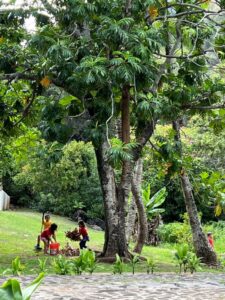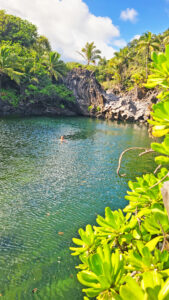A Probiotic for Corals
Researchers seek to save reefs at the microscopic level
Marine researchers at the University of Hawaii and San Diego State University are studying the use of coral probiotics, much like human probiotics, to help coral reefs in their microscopic battles for health.
Though corals worldwide are threatened by rising sea temperatures and other local stressors, much of the wars are fought at the chemical and bacterial levels, the researchers say. Under stress, many reefs usually dominated by coral are now shifting to systems dominated by turf and fleshy algae.
“Understanding the role of bacteria and viruses in ecological processes allows us to think of new and interesting ways to help save corals from local and global stressors,” said Ty Roach, postdoctoral researcher at the Hawaii Institute of Marine Biology, part of the University of Hawaii-Manoa School of Ocean and Earth Science and Technology.
A group of researchers at UH-Manoa and San Diego State published their work titled, “A multiomic analysis of in situ coral — turf algal interactions,” in the Proceedings of the National Academy of Sciences of the United States of America in October. Their research studied the role of bacteria and viruses in the interaction between corals and algae on a coral reef.
Roach, co-lead author, told The Maui News on Wednesday that one approach the Hawaii Institute of Marine Biology is studying to save corals and reefs involves designing an application of coral probiotics, similar to probiotics that humans might take to stimulate internal health and well-being.
“Interestingly, these changes in bacterial groups and their energy use, which comes from feeding on specific chemicals, are similar to changes seen in the human gut, with dominant bacteria linked to obesity,” said co-lead author Dr. Mark Little of SDSU in a news release.
Samples were collected in late 2015 off the Caribbean island of Curacao. The cellular and molecular analysis focused on genes, proteins and metabolic products associated with corals.
Forest Rohwer, senior author of the study and SDSU biology professor, said in the news release that opening up opportunities to engineer and test probiotic blends could “alleviate the effects of stressors on corals.”
“We can also treat corals with beneficial bacteria to help improve reef health,” Roach added. “In this way, we are using ideas from human medicine and thinking about applying them at an ecological scale.”
While the data refer to Caribbean reefs, Roach said Wednesday that he would expect that some of the results “may be generalizable to other reefs with different species of corals and algae” in Hawaii.
“I think understanding how species-specific this response is, is still an open question,” he said.
Increased ocean temperatures triggering coral bleaching and algae blooms are one of the main stressors for reefs worldwide, including Hawaii. Roach said that overfishing, sediment runoff and land use practices can have “serious impacts” on reef health in Hawaii, as well.
But compared to the Caribbean, Hawaii’s marine ecosystem has much healthier levels of bacteria, said Alan Friedlander, chief scientist of Pristine Seas and National Geographic Society and director of the Fisheries Ecology Research Lab at UH.
The Caribbean “is not particularly in great health, there’s a lot of negative influences there– sediments, pollution, overfishing — and it’s a relatively small body of water,” said Friedlander, who did research in the Caribbean in the 1980s. “The Pacific and Hawaii, specifically, are in somewhat better shape because the Pacific is less densely populated in a lot of cases.”
This does not mean that the Hawaiian Islands are in the clear, and there are places that are “heavily impacted,” he said in a phone interview Thursday.
The amount of boat traffic, human contact and pollution from infrastructure built on shorelines, especially in West Oahu and South and West Maui, can hinder fish reproduction and the overall success of the surrounding reefs, he said.
Friedlander is part of a team currently studying the marine ecosystem off Molokini Crater, during a period without snorkelers due to the COVID-19 pandemic. He observed some natural algae blooms during a recent dive but said that the island is still in better condition than most areas because it’s an isolated, off-shore reef.
Depending on the year, blooms vary in size. Some are naturally occurring, while others are a result of stress, he said.
Coral reefs are essential to the marine ecosystem and provide protection from waves and tropical storms, shelter for fish and other organisms, and food for the surrounding wildlife. Restoring coral cover and building reef resilience provide a foundation for a healthy marine ecosystem, Friedlander said.
He supported the idea of engineering coral probiotics or researching superior coral species as “all really good science” to fight microscopic threats, but it requires a lot of time, resources and funding.
“There’s nothing wrong with that, and I think it’s a great addition, but I think our best bet is to protect the areas that are healthy and try to rebuild places that aren’t healthy,” he said. “You can do that with human-engineered solutions, but we have to think about what the root causes of all this and address those.”
* Dakota Grossman can be reached at dgrossman@mauinews.com.
- A team of researchers study Curacao reefs from 2016 to 2018 to investigate the role of bacteria and viruses in the interaction between corals and algae. This photo was provided by Ty Roach, postdoctoral researcher at the Hawaii Institute of Marine Biology, part of the UH-Manoa School of Ocean and Earth Science and Technology. Photo courtesy of Ty Roach
- Protected as a Marine Life Conservation District, Molokini’s surrounding reefs are among the most remote and healthy marine ecosystems in Hawaii. This photo, provided by Kevin Weng, an associate professor at the Virginia Institute of Marine Science, was taken last month during a diver survey. Photo courtesy of Kevin Weng







